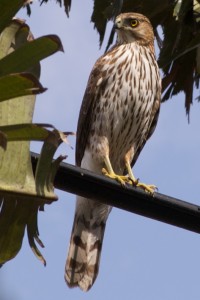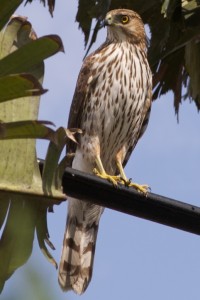This Valentine’s Day I was prowling around the back yard at lunch time as usual, camera in hand. I had the insect-shooting rig (macro lens, flash kit) because noon is normally a pretty poor time for shooting birds. But you never know…
I was in the corner near the firebush when I heard the rapid wingbeats of first one dove, then a couple more. The way doves beat their wings is interesting: they whistle with each wingbeat. The noise is actually part of a distraction strategy to disorient pursuers. When a dove is alarmed, the tempo of the wingbeats speeds up, and the whistling is correspondingly higher-pitched and louder. This “alarm call” probably serves to warn other members of the flock of imminent danger.
And sure enough, when I looked up, there was ample reason for these birds to be afraid: a juvenile accipiter was on their tails! This one, to be precise:


It’s a juvenile by the plumage and the color of the iris; its inexperience probably accounts for the failure of its attack (although capture rates even for experienced accipiters aren’t very good; I’ve read that for mammal prey it’s down near 20%, and for avian prey it’s even lower).
So, do you know which species of accipiter this is? There are basically two choices in our area: Sharp-shinned Hawk or Cooper’s Hawk. Now, there are many ways to differentiate between the two species:
- Sharpies are smaller, but unfortunately the sizes overlap. So size, at least at a distance, isn’t enough by itself.
- Sharpies tend to have squared-off tails, while Cooper’s are rounded. But molt can make this field mark backfire.
- Sharpies’ heads just plain “look small,” while Cooper’s look “tall.” But the angle of the perch can make a tall bird look small, and vice versa.
- Sharpies have “big” streaks on their breasts; Cooper’s have fine streaks. But this pattern is variable.
- Cooper’s Hawks tend to have a more orange-colored head, and Sharpies have a more prominent pale “eyebrow.”
Care to guess which one this is? (No fair reading the captions…)
Go on, give it a try!
